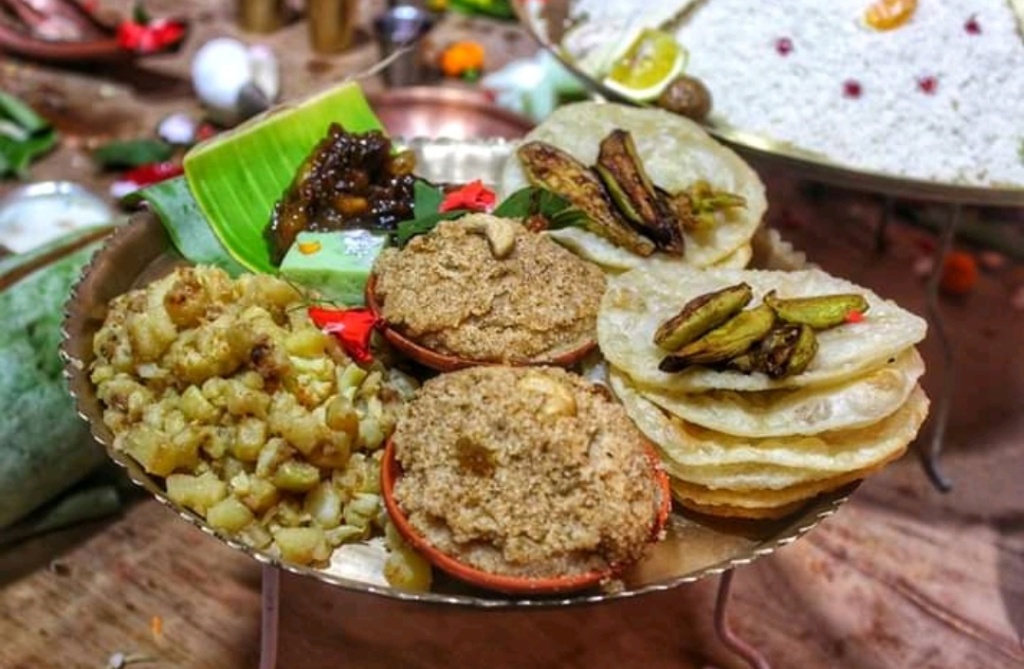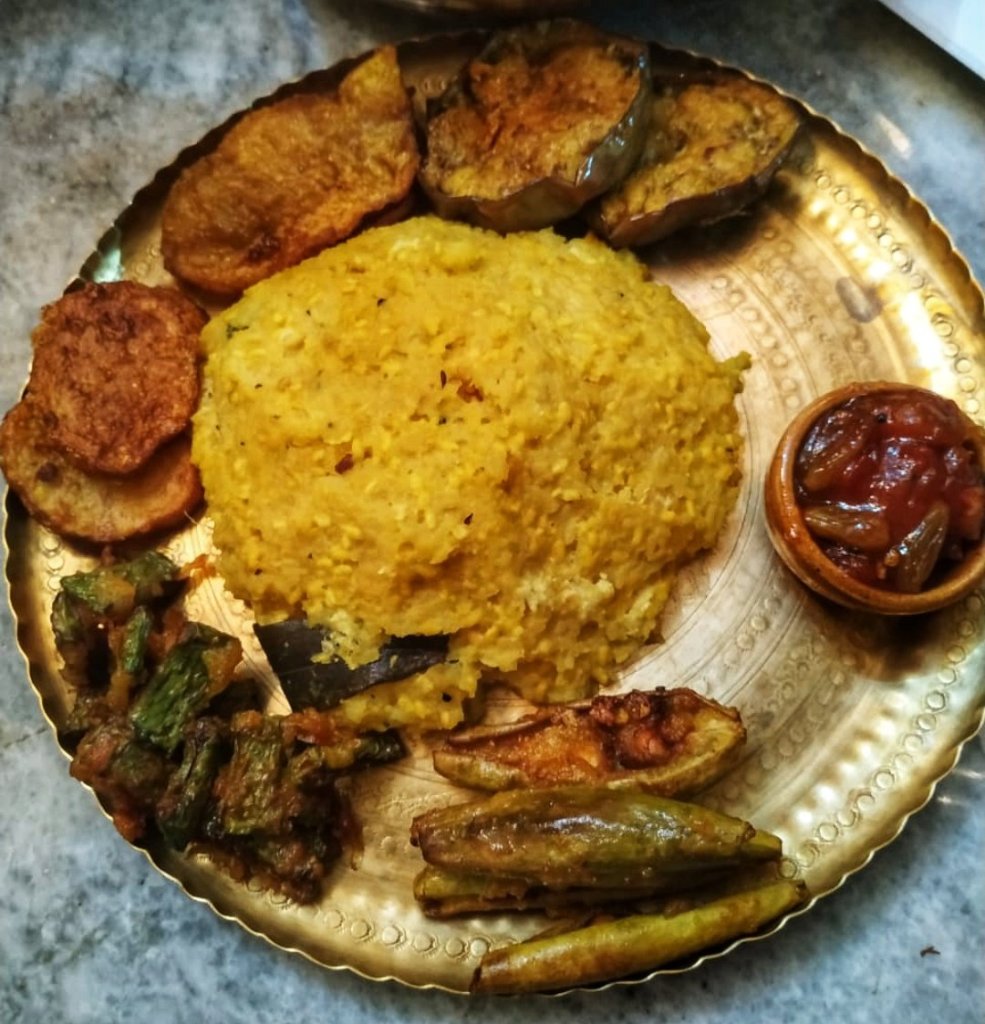I’ve spent thirteen years in a missionary school. It was only when I joined Medical College Kolkata in 2012 that I was introduced to the concept of the school/college Saraswati pujo. From the arrangements and decorations to the pushpanjali, from the innumerable photoshoots in panjabis and saris to the khichuri bhog, it was a magnificent affair.
With just a few days to go before another generation of school and college students partake of this age-old tradition, nostalgia hits hard. A meal that promises both camaraderie and deliciousness, a plate of food that pleases the Goddess and the gastronome alike; that’s about as good as it gets.
Bhog refers to the offerings made to the Goddess and is an integral component of most Hindu pujas. It is believed that the Goddess receives the offering made to her and blesses it. This now deified food is now distributed among devotees who consume it with relish and receive the Goddess’s blessings.
Bhog goes way beyond just a plate of food, and my friend Sudipto Mondal has penned down with incredible eloquence that intangible emotional appeal of this incredible meal, which you can read about here. Do follow his blog for more of such excellent content. https://herunexpectedinception.wordpress.com/2020/01/23/vog_khichuri_ebong/
I, on the other hand, will play the role of the left brain, and stick to the bhog’s more mundane, tangible aspect, breaking it down into its most essential parts. A bhog may comprise a variety of things, from the simple batasha (a kind of sugar drop candy) to the most elaborate of spreads. We, however, will focus our attention on what is by far the most well-known variety: the khichuri bhog.
When dealing with something that is the stuff of nostalgia and countless memories, words can evoke more vivid images than pictures, and that is what I intend to do in this post, so do excuse the paucity of pics in this one. Alright, let’s get going.
Khichuri is the ultimate comfort food. And versatile it is, too. A khichuri can range from the simple and mild, ideal for when you’re feeling a little under the weather, to the rich, indulgent concoction served up in a bhog. It can range from runny and slurpy to relatively dry, almost like a pulao.
At its heart, though, the recipe remains the same: rice and lentils cooked together with spices and sometimes vegetables like potatoes, cauliflower and peas. You could make it more indulgent by roasting the lentils beforehand or adding a wide array of spices and vegetables, but the basic formula remains the same.
The ideal rice for a khichuri is the fragrant, short-grained Gobindobhog rice. It is prized by the Bengalis as much as Italians love their Arborio. Of course, you could use another variety, but the end result is never the same. Although a variety of lentils can be used, roasted moong dal is one of the most common, although you could add others to the mix. A dollop of good quality ghee added in the end makes it even more rich and indulgent.
Khichuri is an eternal favourite of Bengalis; khichuri with fried hilsa (ilish maach bhaja) is a perennial favourite during the monsoons. A simple omelette or pieces of papad go brilliantly with it, too. In a bhog however, khichuri is almost always paired with laabra.
For the uninitiated, laabra refers to a medley of vegetables, and considering the timing of the festivities in Bengal, it is usually made using autumn and winter veggies. Usual candidates for a laabra include potatoes, eggplant, pumpkin, raw bananas, cabbage and cauliflower, among others.
Laabra is the classic accompaniment to khichuri, and for good reason. Both of them contain similar flavourings like ginger, whole spices, turmeric and of course, ghee. A whole array of vegatables go into a good laabra, the number of which may go up to 10 or 15.
Making a good laabra is a labour of love. The vegetables are cooked together with a ginger and handful of spices, most notably paanchforon, a mix of five whole spices which is a bedrock of many Bengali vegetable dishes. Over time, the vegetables soften and the flavours meld, such that they don’t retain their individual flavours by the end, although the rich textural variety remains.
The laabra is finished with a fresh green chillies, a dollop of ghee and a generous quantity of freshly made bhaja moshla, a spice blend dominated by notes of roasted cumin and red chilli. These final touches elevate this humble veggie mélange to an offering fit for the gods.
Winter is when small, waxy, young potatoes are in season, perfect for making alur dom. Chhoto alur dom is a perennial favourite of Bengalis during the winters, paired with radhaballabhi (stuffed with a lentil filling) or koraishutir kochuri (stuffed with a pea filling). Alur dom often replaces the laabra in a bhog.
The bhog version however, has to be niramish, made without onion and garlic. A common substitute ingredient is asafoetida or hing, whose intense oniony flavour makes it a staple ingredient in many Indian vegetarian dishes. Add to that some in-season, fresh peas, and you’ve in heaven.
Khichuri, laabra and alur dom forms the bedrock of the bhog, and despite the complex flavours, the mushiness can get a bit boring after a while. And that is where the the bhaja comes in. “Bhaja” means “fried” in Bengali, and simply involves frying pieces of vegetables in oil. Common varieties include eggplant (begoon), potatoes (aloo), pointed gourd (potol) or pumpkin (kumro). A decent variety of bhajas ensures that almost every mouthful is different.
A more ambitious and indulgent kind of bhaja are the fritters, in which vegetables are dunked in a sample batter of flour, water and a few spices, and fried in oil. A lot of vegetables can be fried this way, although perhaps the most popular is the begooni, in which long thin pieces of eggplant are dunked in a batter and fried. Other candidates include pumpkin and cauliflower.
The crisp exterior and the soft, almost custardy eggplant inside forms a delightful contrast, the perfect textural foil to the khichuri-laabra duo. Begooni isn’t part of a traditional bhog offered to the gods, but it was definitely the highlight of the bhog back in college. While khichuri and laabra used to be ladled out in generous portions, the number of begoonis was strictly rationed to just two per person.
The chutney bridges the savoury and sweet parts of a bhog. It is a sweet and tart concoction made with fruits, sugar, water and flavoured with spices like whole mustard, fennel seeds or paanchforon. A chutney can be made with seasonal ingredients; green mangoes are a popular choice in the summer months. Other, more round-the-year ingredients include tomatoes, dates, pineapple and amshotto (aam papad or mango fruit leather).
The runny chutney is mopped up with pieces of crisp papad, which is not the part of the traditional offering to the Goddess but the perfect accompaniment to the chutney. This chutney-papad duo prepares our palate for dessert. There are a variety of sweets to end the meal with; here, let’s stick to two.
Mishti doi seems to be something that defines Bengali culture. Literally translating to sweet yoghurt, it is something which we Bengalis relish with great enthusiasm. It is made just like any other yoghurt, with an additional crucial step. A caramel is made and when it reaches an amber hue, the milk is added to it and stirred vigorously. The resultant yoghurt has a rich, caramelly complexity and gorgeous reddish-brown hue.
Bengali households usually relegate the duty of making mishti doi to the expert sweetmaker, the “moira”. In the olden days, it used to be the only part of the Bengali meal that was bought fully prepared from the shops. Mishti doi is sold in porous earthen pots, which absorbs more moisture from the yoghurt making it thicker and creamier. A good mishti doi, rich and luscious, will give any crème caramel a run for its money.
This second dessert, unlike the mishti doi, is traditionally made in households rather than being purchased from the sweetshop. Payesh is a variety of rice pudding made with gobindobhog rice, milk and sugar, and the choice of rice is crucial here. The starchy gobindobhog helps thicken the payesh, much like arborio in a risotto. Make a payesh with basmati rice and you’ll realise what I’m talking about.
A note of cardamom is essential, as in many Indian desserts. A special variant is the nolen gurer payesh, where the sugar is swapped for nolen gur or fresh palm jaggery, a winter speciality. Nolen gur stars in numerous Bengali desserts, from rosogolla to sandesh. Few desserts can beat a good nolen gurer payesh, trust me.
Bhog, like the Thanksgiving dinner of the West, is much more than a simple meal. It is a part of our cultural heritage, inseparably incorporated into our social fabric. It is what makes us, us.
Subho Basanta Panchami to all the readers of The Gourmet Glutton.


And the best part is that it does not involve the mindless slaughter of sentient beings just to satiate our very mortal and slowly deteriorating senses.
LikeLike
Absolutely nostalgic and brought back many childhood memories to a person staying away from Kolkata, for a long while now. Saraswati Puja was, is and will always remain an occasion, cherished in my heart of hearts, along with the Royal Meal (Bhog) characterizing the event!!
LikeLike
Reading the blog in Saraswati Puja made me feel that it was always and always about khichuri, labra, papor, chutney and slurrrrp..
LikeLike